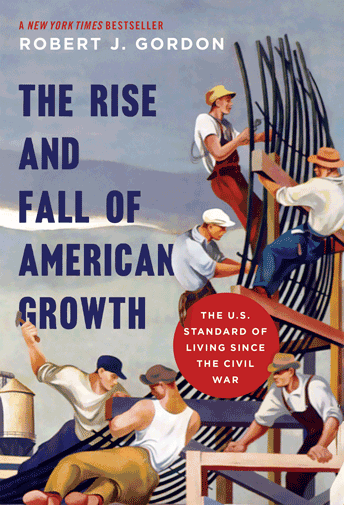
Presidential campaigns incite both hypochondria and euphoria, portraying the present as grimmer than it is and the future as grander than it can be. As an antidote to both, read a rarity, an academic’s thick book (762 pages) widely recognized as relevant to America’s current discontents.
Robert J. Gordon’s “The Rise and Fall of American Growth”
(Buy it at a 29% discount by clicking here or order in KINDLE edition at a 37% discount by clicking here)
argues that an unprecedented and unrepeatable “special century” of life-changing inventions has produced unrealistic expectations, so the future will disappoint: “The economic revolution of 1870 to 1970 was unique. . . . No other era in human history, either before or since, combined so many elements in which the standard of living increased as quickly and in which the human condition was transformed so completely.”
In many ways, the world of 1870 was more medieval than modern.
Three necessities — food, clothing, shelter — absorbed almost all consumer spending. No household was wired for electricity. Flickering light came from candles and whale oil, manufacturing power from steam engines, water wheels and horses. Urban horses, alive and dead, complicated urban sanitation. Window screens were rare, so insects commuted to and fro between animal and human waste outdoors and the dinner table.
A typical North Carolina housewife in the 1880s carried water into her home eight to 10 times daily, walking 148 miles a year to tote 36 tons of it. Few children were in school after age 12.
But on Oct. 10, 1879, Thomas Edison found a cotton filament for the incandescent light bulb. Less than 12 weeks later in Germany, Karl Benz demonstrated the first workable internal combustion engine. In the 1880s, refrigerated rail cars began to banish “spring
sickness,” a result of winters without green vegetables. Adult stature increased as mechanical refrigeration and Clarence Birdseye’s Birds Eye frozen foods improved nutrition.
By 1940, households were networked — electrified, with clean water flowing in and waste flowing out, radio flowing in and telephonic communications flowing both ways.
Today’s dwellings, Gordon says, are much more like those of 1940 than 1940 dwellings were like those of 1900. No more lack of privacy for people living and bathing in the kitchen, the only room that was warm year-round. Since 1940, however, only air conditioning, television and the Internet have dramatically changed everyday life, and these combined have not remotely matched the impact of pre-1940 changes.
Nineteenth-century medicine mostly made patients as comfortable as possible until nature healed or killed them. In 1878, yellow fever killed 10 percent of the Memphis population. But 20th-century medicine moved quickly from the conquest of infectious diseases (the cause of 37 percent of deaths in 1900; 2 percent in 2009) to the management of chronic ailments of the elderly. There were 8,000 registered automobiles in 1900 but 26.8 million in 1930. Ford’s Model T, introduced in 1908 at $950, sold in 1923 for $269.
Gordon says two calamities — the Depression and World War II — fueled the postwar boom: The Depression by speeding unionization (hence rising real wages and declining work hours), the war by high-pressure “productivity-enhancing learning” that, for example, manufactured a bomber an hour at Michigan’s Willow Run plant.
But the classic modernization trek from rural conditions into sanitized urban life and the entry of women into the workforce were vast, unrepeatable advances. Today the inflation-adjusted median wage of American males is lower than in 1969, and median household income is lower than when this century began. If the growth rate since 1970 had matched that of 1920 to 1970, instead of being one-third of it, per capita gross domestic product in 2014 would have been $97,300 instead of $50,600.
America’s entitlement state is buckling beneath the pressure of an aging population retiring into Social Security and Medicare during chronically slow economic growth. Gordon doubts the “techno-optimists” who think exotic developments — robots, artificial intelligence, etc. — can match what such by-now-banal developments as electricity and the internal combustion engine accomplished.
There is, however, no reason to expect that medical advances have been exhausted. And there are many reasons to believe that the rapid expansion of regulatory, redistributive government, which can be reformed, has contributed to — it certainly has coincided with — the onset of (relative) economic anemia.
The “fatal conceit” (Friedrich Hayek’s term) is the optimistic delusion that planners can manage economic growth by substituting their expertise for the information generated by the billions of daily interactions of a complex market society.
Gordon’s stimulating book expresses a pessimist’s fatal conceit, the belief that we know the future will be less creative than the “special century.”
Comment by clicking here.



 Contact The Editor
Contact The Editor
 Articles By This Author
Articles By This Author